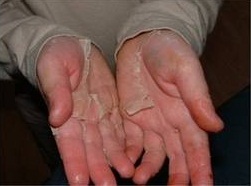



Peeling skin is typically the result of damage to and loss of the uppermost layer of skin. There are a number of reasons for peeling skin, including direct damage due to infection and sunburn, autoimmune disorder, or other types of disease. Along with the peeling skin you may also experience itching, dryness, rash and other skin irritations.
Because your skin is the first line of the body’s defense, it is always exposed to a variety of substances, as well as environmental factors such as heat, dryness, excessive humidity, wind, cold and the sun. All of these factors can irritate the skin and even damage it. Repeated irritation can eventually lead to the skin peeling. Some causes of skin peeling include:
Fungal infections, such as jock itch, ringworm and athlete’s foot, can cause the skin to peel due to irritation. Some types of staph and other infections can also cause sufficient irritation that leads to skin peeling.
Sometimes certain substances can cause allergic reactions in people, resulting in skin irritation. Cosmetics, detergents, certain fabrics and latex can cause irritation and peeling of the skin. At times, certain foods that cause reactions can irritate the skinas well.
Toxic shock syndrome, which can be caused by staph or strep bacteria, can cause skin reactions that lead to irritation and peeling. Other immune disorders can also cause irritation and peeling, such as a group of rare skin conditions called pemphigus.
Certain cancers such as adult non-Hodgkins lymphoma can cause skin rashes and other irritations that can lead to skin peeling.At the same time, some cancer treatments can also lead to the peeling of the skin due to different reactions and irritations.
Besides all the causes mentioned above, here we list the most common diseases that cause peeling hands.
|
Athlete’s Foot |
Contact Dermatitis |
Cutaneous T-cell Lymphoma |
Dry skin |
Eczema (Atopic dermatitis) |
Jock itch |
|
Kawasaki Disease |
Pemphigus |
Psoriasis |
Ringworm of the scalp |
Ringworm of the body |
Scarlet fever |
|
Seborrheic dermatitis |
Side effects of certain medications |
Staph infections |
Stevens-Johnson syndrome |
Sunburn |
Toxic shock syndrome |
Note:
You should always consult your health care provider when your skin is peeling and you are unclear of the causes. Immediately consult your doctor if the peeling is accompanied by signs of infection such as crusting, oozing fluids or pus. Topical medications can help heal infections and add moisture to your skin. If you do experience peeling skin, do not pick at it as that can lead to infection.
The skin around the hands is delicate and sensitive, making peeling in this area a potential problem which causes discomfort and embarrassing. Peeling hands is usually a temporary problem that will clear up in a few days as new skin begins to grow. If peeling is a serious concern for you, there are some natural home remedies that you can try to speed up the healing and stop your hands peeling.
|
Home Remedy |
Why It Works |
|
Warm water |
It sounds so simple, but it works in two ways. The skin around your hands will become soft and supple, eliminating dryness. It will then help the peeling skin fall off. |
|
Aloe Vera |
Applying pure Aloe Vera gel to hands will help moisturize skin as well as cool and soothe skin. |
|
Cucumber |
Cucumber has the same effect as the warm water because of the high water content. It will moisturize the skin and help it peel off. |
|
Coconut oil |
Coconut oil has many anti-bacterial and anti-fungal properties to protect your skin. It also moisturizes and helps get rid of the peeling skin. |
|
Olive oil |
Rich in fatty acids and vitamin E, olive will soothe and moisturize skin and help end peeling. |
|
Milk |
Milk is very moisturizing to the skin, whether you drink it or apply it to your skin. |
|
Oats |
Oats is long considered an effective remedy for treating many skin conditions since it will help slough off the peeling skin and leave hands soft and moisturized. |
|
Honey |
Honey is a natural antibacterial, so it will heal and protect skin from infection while moisturizing and soothing peeling skin. |
|
Mint juice |
As a natural moisturizer, it is great for treating dry, irritated skin. Mint juice also contains natural healing properties to heal and protect skin. |
|
Banana |
Bananas are another natural moisturizer that can be applied to the skin on your hands to help soothe skin and eliminate peeling. |
Once you have begun to care for the peeling skin on your hands, there are some dos and don’ts that you should keep in mind.
|
Dos |
Don’ts |
|
Moisturize your skin regularly, especially in cold weather and always apply sunscreen to protect your hands from the sun. |
Avoid cutting or damaging skin on hands that is peeling and do not pick at peeling skin. This can lead to infection and scarring. |
|
Drink at least eight to ten glasses of water a day to replenish lost fluids and stay hydrated. |
Avoid using potentially harsh soaps and shampoos and switch to gentler soaps and washes that will be easier on skin. |
|
Rough, dry skin can be a sign of a vitamin deficiency, so be sure to add vitamin A, C, and E rich foods to your diet to keep skin naturally moisturized. |
Avoid taking baths or showers that are too hot as this can strip natural emollients and moisturizers from skin. |
|
When washing dishes or doing other chores that might expose your hands to harsh chemicals, always protect your hands by wear cotton-lined latex gloves. |
Do not wash your hands too often as this can strip natural emollients from the skin, drying it out. |